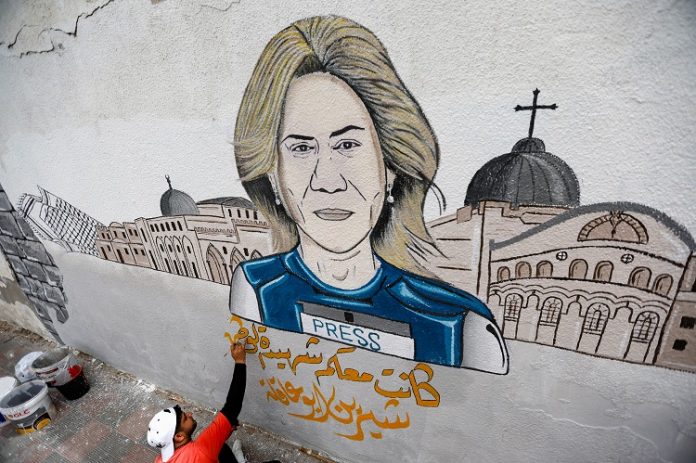Jerusalem: As Israel and the Palestinians wrangle over the investigation into the killing of Al Jazeera journalist Shireen Abu Akleh, several independent groups have launched their own probes.
One open-source research team said its initial findings lent support to Palestinian witnesses who said she was killed by Israeli fire.
The outcome of these investigations could help shape international opinion over who is responsible for Abu Akleh’s death, particularly if an official Israeli military probe drags on.
Israel and the Palestinians are locked in a war of narratives that already has put Israel on the defensive.
Abu Akleh, a Palestinian-American and a 25-year veteran of the satellite channel, was killed last Wednesday while covering an Israeli military raid in the Jenin refugee camp in the occupied West Bank. She was a household name across the Arab world, known for documenting the hardship of Palestinian life under Israeli rule, now in its sixth decade.
Secretary of State Antony Blinken on Sunday said he had spoken to Abu Akleh’s family to express condolences and respect for her work “as well as the need to have an immediate and credible investigation” into her death.
Palestinian officials and witnesses, including journalists who were with her, say she was killed by army fire. The military, after initially saying Palestinian gunmen might have been responsible, later backtracked and now say she might have been hit by errant Israeli fire.
Israel has called for a joint investigation with the Palestinians, saying the bullet must be analyzed by ballistics experts to reach firm conclusions. Palestinian officials have refused, saying they don’t trust Israel.
Human rights groups say Israel has a poor record of investigating wrongdoing by its security forces.
After earlier saying they would accept an outside partner, the Palestinians said late on Sunday they would handle the investigation alone and deliver results very soon.
“We also refused to have an international investigation because we trust our capabilities as a security institution,” Prime Minister Mohammed Shtayyeh announced. “We will not hand over any of the evidence to anyone because we know that these people are able to fasify the facts.” He stood with Abu Akleh’s brother, Anton and Al Jazeera’s local bureau chief, Walid Al-Omari.
With the two sides at loggerheads over the Abu Akleh probe, several research and human rights groups have launched their own investigations.
Over the weekend, Bellingcat, a Dutch-based international consortium of researchers, published an analysis of video and audio evidence gathered on social media. The material came from both Palestinian and Israeli military sources and the analysis looked at such factors as time stamps, the locations of the videos, shadows and a forensic audio analysis of gunshots.
The group found that while gunmen and Israeli soldiers were both in the area, the evidence supported witness accounts that Israeli fire killed Abu Akleh.
“Based on what we were able to review, the IDF (Israeli soldiers) were in the closest position and had the clearest line of sight to Abu Akleh,” said Giancarlo Fiorella, the lead researcher of the analysis.
Bellingcat is among a growing number of firms that use “open source” information, such as social media videos, security camera recordings and satellite imagery, to reconstruct events.
Fiorella acknowledged that the analysis cannot be 100 per cent certain without such evidence as the bullet, weapons used by the army and GPS locations of Israeli forces. But he said the emergence of additional evidence typically bolsters preliminary conclusions and almost never overturns them.
“This is what we do when we don’t have access to those things,” he said.
The Israeli human rights group B’Tselem said it too, is conducting its own analysis. The group last week played a key role in the military’s backtracking from its initial claims that Palestinian gunmen appeared to be responsible for her death.
The Israeli claim was based on a social media video in which a Palestinian gunman fires into a Jenin alleyway, and then other militants come running to claim they have shot a soldier. The army said that because no soldiers were hurt that day, the gunmen might have been referring to Abu Akleh, who was wearing a protective helmet and flak jacket.
A B’Tselem researcher went to the area and took a video showing that the Palestinian gunmen were some 300 metre away from where Abu Akleh was shot, separated by a series of walls and alleyways.
Dror Sadot, a spokeswoman for the group, said B’Tselem has begun gathering testimonies from witnesses and may attempt to reconstruct the shooting with videos from the scene. But she said at this point, it has not been able to come to a conclusion about who was behind the shooting.
Sadot said any bullet would need to be matched to the barrel of the gun. The Palestinians have refused to release the bullet, and it is unclear whether the military has confiscated the weapons used that day.
“The bullet on its own can’t say a lot” because it could have been fired by either side, she said. “What can be done is to match a bullet to the barrel,” she said.
The Israeli military did not respond to interview requests to discuss the status of its probe.


